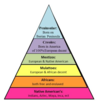Reactions to Revolutionary Ideals Flashcards
Toussaint L’Overture
In 1791, while France was in the midst of the French Revolution, a large slave revolt against French rule broke out in Haiti. By 1793, French forces had been largely defeated by Haitian forces under the leadership of Toussaint L’Ouverture. L’Overture was heavily influenced by the enlightenment and used guerilla tactics to combat French forces.
Simon Bolivar
Simón Bolívar led many of the Central and South American nations in their wars for independence against Spain and Portugal, beginning in 1815. Bolivar was heavily influenced by the Enlightenment and French Revolution. A member of the Creole class in Venezuela, Bolívar led revolutions against Spanish authority in Venezuela, Bolivia, Ecuador, and Colombia, beginning in 1815. Known as “ The Liberator.”
Jose de San Martin
Another revolutionary in South America who was influenced by the Enlightenment and led independence movements in Argentina and Chile in the 1810s.
Prince Clemens von Metternich
Austrian Prince who led the Congress of Vienna in 1815 after the defeat of Napoleon.
Congress of Vienna 1815
A meeting held to restore Europe back to the way it was before the French Revolution. The Congress had several goals and actions to accomplish this. Goal 1 Prevent France from militarizing again Action 1 Strengthened the countries surrounding France Goal 2 Return Europe to the way it ways before Napoleon Action 2 Bring back absolute monarchies Goal 3 Maintain peace Action 3 Create a “Concert of Europe” or organization to protect the peace in Europe.
Russification
The large Russian nation is made up of many different ethnic minorities. In a time threatened by Enlightenment ideas and revolution, Russian czars implemented a policy of Russification as an attempt to make all groups think, act, and believe as Russians. This was designed to control the masses and prevent revolution. One national language and religion was enforced. The Jewish minority was discriminated against as a result of intense feelings of nationalism.
Oligarchy
A country ruled by a small, powerful elite.
How did geography create instability in Latin America in the Post-Revolutionary era?
Geographic Barriers - the Andres Mountains prevented communication between newly independent states. This prevented the creation of one united country of newly independent states after independence was achieved from Spain.
How did social injustice create instability in Latin American in the Post-Revolutionary era?
Despite the establishment of democratic forms of government, the colonial social structure still remained intact. Creoles replaced Peninsulares as the ruling class.

How did caudillos create instability in Latin American in the Post-Revolutionary era?
Newly independent countries had little experience with self-government. As a result, local military strongmen called caudillos assembled their own militias and challenged the government’s power.
How did the Church create instability in Latin America in the Post-Revolutionary era?
The Roman Catholic Church owned a great deal of land and had tremendous power in Latin America. The Church pushed to preserve the old order in Latin America for its own interest and further resisted revolutionary ideas that would weaken its position.
How did economic issues create instability in Latin America in the Post-Revolutionary era?
Latin American colonies were dependent on trade with Spain and Portugal. The colonies relied on cash crops in order to profit. Each area had one or two crops that they would send over to Europe. This makes the colonies very unstable since their economy was based on only 1 or 2 crops.
Causes of the Mexican Revolution
Porfirio Diaz ruled Mexico as a dictator during the 1800s to early 1900s. Although he brought economic improvements to the country, he rigged elections and imprisoned those who spoke out against him. Eventually, the masses who were left uneducated, landless and poor revolted against Diaz.
Emiliano Zapata
An Indian leader of the Mexican Revolution who led a large peasant revolt in the south. Zapata called for land reform.
Francisco “Pancho” Villa
Rebel leader of the Mexican Revolution. Popular amongst the peasant population in the North.
Effects of the Mexican Revolution
The Constitution of 1917 was created granting land reform and rights to workers and women. Social Reform - libraries and schools were established. Economic Nationalism - the people were inspired to end their reliance on foreign countries for economic stability. Cultural Nationalism - writers and authors began rejecting European culture and embracing their own.
Latin American Independence Movements
Toussaint L’Ouverture - Haiti (fighting French)
Simon Bolivar - South America (the Liberator) - Fighting Spain
Jose de San Martin - South America
Fighting Imperialism
Mexican Revolution Leaders
Porfirio Diaz
Emiliano Zapata
Franciso “Pancho” Villa
Encomienda System
In Spanish colonies
Spain allows conquistador to own a sugar plantain
Natives demanded to work as slaves
Social classes


